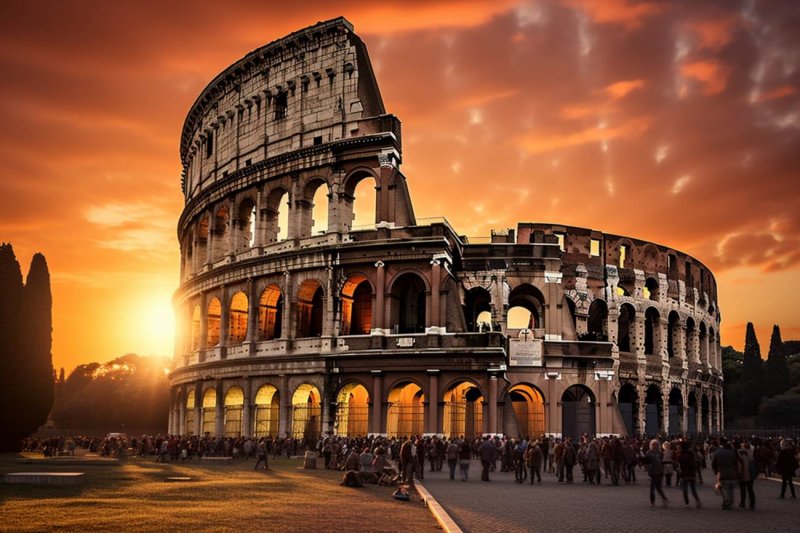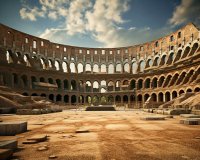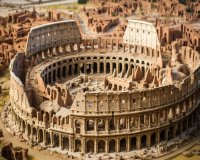Walking Through History: Colosseum and Palatine Hill

Walking Through History: Colosseum and Palatine Hill in Rome
When you think of Rome, the Colosseum is likely one of the first landmarks that come to mind. This iconic amphitheater, also known as the Flavian Amphitheatre, is a symbol of both Roman engineering and entertainment. As you explore the Colosseum and nearby Palatine Hill, you're essentially walking through history, unraveling the stories of ancient Rome.
Let's embark on a virtual journey to discover the rich history, architecture, and significance of these remarkable sites.
The Colosseum: A Marvel of Ancient Engineering
The Colosseum, built in AD 70-80, is a true marvel of ancient engineering. This elliptical amphitheater could hold up to 80,000 spectators, making it one of the largest ever built. Its iconic exterior, featuring massive arched entrances and tiered seating, is a testament to the architectural prowess of the Romans.
Originally used for gladiatorial contests and public spectacles, the Colosseum witnessed epic battles, chariot races, and even mock sea battles thanks to its ingenious design that allowed for flooding the arena. The arena floor, called the "harena" or sand, was covered with removable wooden flooring to accommodate various events.
While the Colosseum is a symbol of entertainment, it also has a darker history associated with the suffering and death of countless gladiators and animals. As you stand within its grand walls, you can't help but feel the weight of its history.
Palatine Hill: The Birthplace of Rome
Adjacent to the Colosseum is Palatine Hill, one of the most ancient parts of the city. Legend has it that this is where Romulus and Remus, the mythical founders of Rome, were found and raised by a she-wolf. Today, Palatine Hill stands as a serene oasis of lush gardens, ruins, and breathtaking views of the Roman Forum and Circus Maximus.
Wandering through the ruins on Palatine Hill, you'll come across the remains of grand palaces that once belonged to Roman emperors. The most famous of these is the Domus Augustana, the private residence of the emperors, which boasted luxurious living quarters and magnificent gardens.
Visiting Palatine Hill offers a glimpse into the opulence and grandeur of ancient Roman life. You can stroll through the same paths where emperors once walked, and marvel at the mosaics and frescoes that adorned their palaces.
The Significance of the Colosseum and Palatine Hill
The Colosseum and Palatine Hill are not just tourist attractions; they are living museums that bear witness to the rise and fall of the Roman Empire. They are a testament to the ingenuity and ambition of ancient Roman builders, the grandeur of imperial life, and the sometimes brutal nature of Roman entertainment.
Today, these sites are recognized as UNESCO World Heritage Sites, and they continue to draw millions of visitors from around the world. They are an essential stop for history enthusiasts, archaeology buffs, and anyone interested in understanding the roots of Western civilization.
So, as you walk through history at the Colosseum and Palatine Hill, remember that you are treading on the same ground where gladiators fought for their lives, emperors ruled with absolute power, and legends of Rome's founding took root. It's a journey that will not only leave you in awe of the past but also make you appreciate the enduring legacy of ancient Rome.
Rome: Colosseum Arena, Roman Forum, and Palatine Hill Tour
Follow your guide through the Colosseum's arena floor, the Roman Forum, and the Palatine Hill on a walking tour. Dive into the lives of history’s greatest ever sportsmen: Gladiators.
Details
Imagine roaring crowds above you as you walk through the Gladiators’ Gate. Learn about the lives of gladiators, including training and living conditions. Understand the intricate engineering systems under the Colosseum’s arena floor. Visit the triumphal arches of two mighty emperors, Titus and Constantine. Climb the famous Palatine Hill for stunning views of the sprawling city below.
Meeting point:
Meet your guide at the Arch of Constantine. Which is near the Piazza del Arco di Costantino. Open in Google Maps
Important information:
All visitors must pass through airport-style security. Changes to the tour may happen (upon agreement) if the minimum number of participants cannot be reached.
The Legacy of the Colosseum in Rome
The Colosseum, also known as the Flavian Amphitheatre, stands as a symbol of ancient Rome's grandeur, architectural innovation, and cultural significance. This iconic structure's legacy transcends the boundaries of time, leaving an indelible mark on both Rome's history and the world at large.
Construction of the Colosseum began in AD 70-72 under the emperor Vespasian and was completed in AD 80 by his son Titus. Located in the heart of Rome, the Colosseum was an engineering marvel, showcasing Roman prowess in architecture and design. It is the largest amphitheater ever built, with a seating capacity of approximately 50,000 spectators, illustrating the Romans' exceptional skill in handling massive construction projects.
The Colosseum served as a multifunctional arena, hosting a wide range of events, including gladiatorial contests, animal hunts, mock sea battles, and dramatic performances. These events not only provided entertainment but also reinforced the political and social control of the Roman emperors. The spectacles showcased the empire's power and its rulers' generosity to the people.
One of the most enduring images associated with the Colosseum is that of gladiators battling to the death. These fighters were typically slaves, prisoners, or volunteers, and their combat was a brutal form of entertainment. The Colosseum was where they fought for their lives, and it is estimated that hundreds of thousands of gladiators met their fate within its walls.
While the Colosseum's past is filled with violent and bloody spectacles, its legacy today symbolizes something more profound. It has become a global emblem of ancient Roman culture, architecture, and engineering excellence. The Colosseum's enduring appeal lies in its ability to connect us to a bygone era, offering a window into the lives of those who lived nearly two millennia ago.
Over the centuries, the Colosseum has faced various challenges, including earthquakes, fires, and the removal of its original marble façade, which was repurposed in the construction of other buildings. Despite these trials, the Colosseum has stood the test of time, remaining a prominent tourist attraction and a UNESCO World Heritage Site.
Restoration efforts have played a significant role in preserving the Colosseum's structural integrity and its legacy. These initiatives have sought to repair damage and ensure the continued safety of visitors to this historic site. The Colosseum's enduring popularity is a testament to the human fascination with history and the desire to connect with the past.
The Colosseum's Impact on Modern Culture
The Colosseum's influence extends far beyond its historical significance. It has left an indelible mark on popular culture, inspiring countless films, books, and works of art. Its image is instantly recognizable, and its iconic status continues to captivate people worldwide.
Perhaps one of the most famous references to the Colosseum in modern cinema is in the movie "Gladiator" (2000), where Russell Crowe's character, Maximus, battles in the arena. The film brought the grandeur and brutality of the Colosseum to a new generation, cementing its place in the collective imagination.
Artists, writers, and architects have drawn inspiration from the Colosseum for centuries. Its elliptical shape, the intricate network of tunnels and chambers beneath its floor, and its soaring arches have been depicted in countless works of art and literature. The Colosseum's enduring appeal as a subject of creative expression speaks to its timeless significance.
In addition to its cultural impact, the Colosseum continues to play a crucial role in tourism, drawing millions of visitors each year. Its status as a symbol of Rome and the Roman Empire ensures its place as one of the most visited historical sites globally.
In Conclusion
The Colosseum in Rome stands as a testament to the grandeur and complexity of ancient Roman civilization. Its enduring legacy is a reflection of the Romans' architectural ingenuity, their thirst for entertainment, and their political control. While its history is marked by violence and spectacle, today, the Colosseum represents a bridge between the past and the present, reminding us of the rich tapestry of human history.
As a global icon and a source of inspiration for art and culture, the Colosseum's influence continues to resonate. Its enduring legacy serves as a reminder of the power of human achievement and the timeless allure of history.
Rome: Skip-the-Line Colosseum, Forum, and Palatine Tour
Explore the wonders of Ancient Rome on this guided walking tour featuring skip-the-line access to the Colosseum, Roman Forum, and Palatine Hill. Led by a knowledgeable local guide, step back in time to the origins of Rome, where history comes alive amidst the ancient ruins.
Highlights
- Admire panoramic views of Rome's landscape from the Palatine Hill.
- Travel back in time while exploring the Roman Forum archaeological area.
- Discover Rome's most recognized monument: the mighty Colosseum.
- Hear fascinating stories of emperors and ancient Roman life from your guide.
- Skip the ticket lines for faster access to the Colosseum and Roman Forum.
About this Activity
Embark on a 3-hour journey through the heart of Ancient Rome, delving into its rich history and architectural marvels. With skip-the-line entry, dive into the Colosseum's first and second tiers, then explore the Roman Forum, an iconic archaeological site. Finally, ascend the Palatine Hill to capture unbeatable photos of Rome's skyline.
Meeting Point
Please arrive 10 minutes early at the green souvenir kiosk in front of the “Colosseo” metro stop. Look for the representative holding a sign with The Tour Guy's name.
Important Information
- What to bring: Passport or ID card, comfortable shoes, sunscreen, and weather-appropriate clothing.
- Not allowed: Luggage or large bags.
- Stay informed: Recent changes in reservation procedures by the Colosseum might lead to tour start time changes or cancellations. You'll be notified in advance for rescheduling if necessary.
Customer Reviews
Rated 4.4/5 based on 1370 reviews. Visitors praised the informative guides, efficient planning, and the opportunity to explore Rome's iconic sites hassle-free.
One visitor, Mel from the United Kingdom, highlighted the excellent planning of the tour, ensuring a fulfilling experience. Another guest, Gavin from the Netherlands, appreciated the passionate and informative guide who provided panoramic views of the Roman Forum and Colosseum.
Don't miss this chance to uncover the secrets of Ancient Rome with expert guidance!
Mysteries of Palatine Hill, Rome: Unraveling the Ancient Enigma
Nestled in the heart of Rome, Palatine Hill stands as a silent witness to centuries of history, shrouded in mysteries that continue to captivate historians and archaeologists alike.
Historical Significance:
Palatine Hill is one of the Seven Hills of Rome, and its history dates back to the legendary founding of Rome itself. According to Roman mythology, it was on this very hill that the she-wolf, Lupa, nursed the abandoned twins Romulus and Remus, who would go on to establish the city of Rome. The hill became the residence of emperors and aristocrats, evolving into a symbol of power and opulence.
Archaeological Marvels:
The archaeological site on Palatine Hill is a treasure trove of ancient ruins, including the remains of imperial palaces, luxurious villas, and temples. The House of Augustus and the Domus Flavia are among the notable structures that provide insights into the daily lives of Roman elites. Visitors can wander through the intricate mosaics and frescoes that have survived the test of time.
Mysterious Structures:
One of the enduring mysteries of Palatine Hill is the Lupercal, a cave believed to be the legendary site where the she-wolf nursed Romulus and Remus. While its exact location remains speculative, the significance of the Lupercal in Roman mythology adds an air of mystique to the hill.
Emperor's Palaces:
The imperial palaces on Palatine Hill, including the House of Augustus and the House of Livia, offer a glimpse into the lavish lifestyles of Roman emperors. Lavish frescoes, grand courtyards, and sprawling gardens showcase the wealth and power of Rome's rulers during the height of the Roman Empire.
Palatine Museum:
For those eager to delve deeper into the mysteries of Palatine Hill, the Palatine Museum is a must-visit. Housing artifacts recovered from the archaeological site, the museum provides context to the historical and cultural significance of the hill. Exhibits range from statues of emperors to everyday objects used by ancient Romans.
Legends and Lore:
Palatine Hill is steeped in legends and folklore, adding an extra layer of intrigue. The tale of Hercules defeating the monster Cacus on the hill and the connection to the Roman festival of Lupercalia contribute to the mystique surrounding this ancient site.
Conclusion:
In conclusion, Palatine Hill stands as a testament to the rich tapestry of Rome's history. From its mythical origins to the grandeur of imperial palaces, every stone has a story to tell. Exploring the mysteries of Palatine Hill is not just a journey through time but an immersion into the enigmatic allure of one of Rome's most iconic landmarks.






